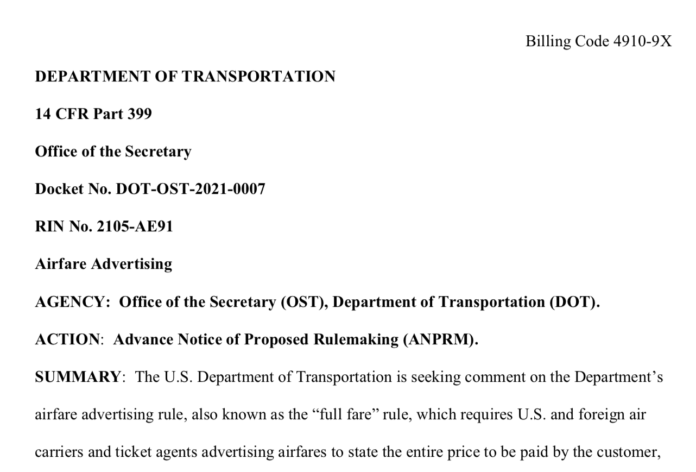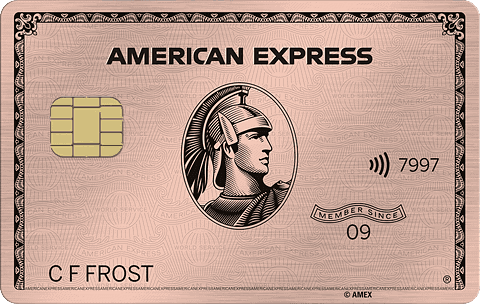
In this article
History of the Full Fare Advertising Rule
Prior to 2006, airlines were not required to display the total cost of a flight in an advertisement as one “all-in” figure.
You would see things like this:
$99
(Plus $384 taxes and fees)
Today, that same ad would be required to simply state:
$483
Now, I don’t doubt that you are capable of doing the math on the former, but why would anyone think that it’s better for the consumer to have to do any math to figure out a final price. That’s absurd on the face of it and why the rule went into effect to end the practice.
The DOT is Seeking Feedback on Amending the Rule
On January 15th, the DOT published an “Advanced Notice of Proposed Rulemaking” that is seeking comments to be submitted for their review.
In 2017, the airlines began a campaign to lobby for removal of this rule, so that they could go back to deceptive advertising practices with the rationale that the “full fare rule subjects airlines to price advertising requirements that are different from most other businesses and industries in the United States, including other modes of transportation that are potential competitors of the aviation industry, that the Department adopted the full fare rule without meaningful evidence of consumer confusion under the prior enforcement policy, and that the rule was premised on a flawed cost-benefit regulatory impact analysis.” (excerpted from the DOT filing)
This is absurd from a consumer’s perspective, however when you realize that hotels are legally allowed to muddy their prices with resort fees, you can (kind of) see their point.
Of course, the answer should be the end of resort fees for the same reasons that the airlines had to change to less-deceptive practices in 2006. The consumer is never done a favor by having to do more work to figure out an all-in price and search engines that display pricing are not uniform when it comes to “extra fees,” often sorting by base prices (meaning that the cheapest result may be far from the cheapest result once all fees are added in).
In rebuttal to the 2017 airline campaign, “Consumer advocacy groups also filed a joint comment stating that knowing the full fare is central to ensuring that the free market forces work for consumers because consumers can only make informed buying decisions based on the full price.” (excerpted from the DOT filing)
How Can You Send a Comment to the US DOT?
So, why am I posting about this?
Because it would be a horrendously bad move if the DOT were to overturn this rule and they need to hear from us in droves.
Here is a link to the proposal document – click the blue COMMENT box to leave a comment.
On Tuesdays and Thursdays when they are using a beta site, you may need this link instead if the above one doesn’t work
(Note that anything you write is public domain).
If you enjoy seeing the actual price of your airfare in advertisements, you really should consider giving the DOT feedback. We need an overwhelming response to ensure that the airline lobby groups can’t pull a fast one on us.

The DOT explicitly states that one well written comment is worth more than a thousand submissions of a form letter, so I am not going to paste what I wrote. I’m sure you can put into your own words why you prefer to see the total price of a flight in an ad as opposed to a base fare plus taxes and fees where you have to figure out the final price for yourself. If you need inspiration, just think about how much you hate resort fees for the same reason.
If you don’t comment, you won’t be able to moan if the rule changes and you need to grab your calculator to run your Expedia searches.
(HT to Seth Miller for Tweeting about this.)
Thoughts?
Let me know below in the comments, on Twitter, or in the private MilesTalk Facebook group. And don't forget to follow me on Instagram for all sorts of tips on miles, points, credit cards, and travel.
If this post helped you, please consider sharing it!
You can find credit cards that best match your spending habits and bonus categories at Your Best Credit Cards.
New to all of this? My “introduction to miles and points” book, MilesTalk: Live Your Wildest Travel Dreams Using Miles and Points is available on Amazon and at major booksellers.

















Is there a way to comment on mobile? Just clicked the link and I didn’t see a space to say anything.
Try the revised link in the post. Apparently on Tuesdays and Thursdays they use a Beta site that functions differently. The new link works for both downloading the Notice and for clicking the blue Comment box that takes you to the form.
For an Australian, non-inclusive pricing on anything is prohibited. We have a uniform 10% GST across the country. What you see on a menu, on the shelf at the supermarket, on your bill at the hotel, it’s all required by law to be the bottom line. Coming from that to a place like the US where nothing is tax inclusive and as tourist you’ve know idea what the tax is until you get to the register, it’s very frustrating.
I totally agree and when traveling I really appreciate the kind of pricing you see in most of the world (all-in). Even for an American at home, it can be frustrating to see something marked on sale for $10 and pull out a crisp $10 only to have it rung up for $10.88 or whatever the local tax rate is. Would love all pricing to just be what you need to actually pay and the business has priced it to include the tax.